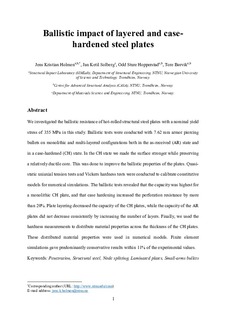| dc.contributor.author | Holmen, Jens Kristian | |
| dc.contributor.author | Solberg, Jan Ketil | |
| dc.contributor.author | Hopperstad, Odd Sture | |
| dc.contributor.author | Børvik, Tore | |
| dc.date.accessioned | 2017-10-10T08:45:05Z | |
| dc.date.available | 2017-10-10T08:45:05Z | |
| dc.date.created | 2017-10-09T11:45:23Z | |
| dc.date.issued | 2017 | |
| dc.identifier.issn | 0734-743X | |
| dc.identifier.uri | http://hdl.handle.net/11250/2459360 | |
| dc.description.abstract | We investigated the ballistic resistance of hot-rolled structural steel plates with a nominal yield stress of 355 MPa in this study. Ballistic tests were conducted with 7.62mm armor piercing bullets on monolithic and multi-layered configurations both in the as-received (AR) state and in a case-hardened (CH) state. In the CH state we made the surface stronger while preserving a relatively ductile core. This was done to improve the ballistic properties of the plates. Quasi-static uniaxial tension tests and Vickers hardness tests were conducted to calibrate constitutive models for numerical simulations. The ballistic tests revealed that the capacity was highest for a monolithic CH plate, and that case hardening increased the perforation resistance by more than 20%. Plate layering decreased the capacity of the CH plates, while the capacity of the AR plates did not decrease consistently by increasing the number of layers. Finally, we used the hardness measurements to distribute material properties across the thickness of the CH plates. These distributed material properties were used in numerical models. Finite element simulations gave predominantly conservative results within 11% of the experimental values. | nb_NO |
| dc.language.iso | eng | nb_NO |
| dc.publisher | Elsevier | nb_NO |
| dc.rights | Attribution-NonCommercial-NoDerivatives 4.0 Internasjonal | * |
| dc.rights.uri | http://creativecommons.org/licenses/by-nc-nd/4.0/deed.no | * |
| dc.title | Ballistic impact of layered and case-hardened steel plates | nb_NO |
| dc.type | Journal article | nb_NO |
| dc.type | Peer reviewed | nb_NO |
| dc.description.version | acceptedVersion | nb_NO |
| dc.source.journal | International Journal of Impact Engineering | nb_NO |
| dc.identifier.doi | 10.1016/j.ijimpeng.2017.02.001 | |
| dc.identifier.cristin | 1503310 | |
| dc.relation.project | Norges forskningsråd: 237885 | nb_NO |
| dc.description.localcode | © 2017. This is the authors’ accepted and refereed manuscript to the article. LOCKED until 2.2.2019 due to copyright restrictions. This manuscript version is made available under the CC-BY-NC-ND 4.0 license http://creativecommons.org/licenses/by-nc-nd/4.0/ | nb_NO |
| cristin.unitcode | 194,64,45,0 | |
| cristin.unitcode | 194,66,35,0 | |
| cristin.unitname | Institutt for konstruksjonsteknikk | |
| cristin.unitname | Institutt for materialteknologi | |
| cristin.ispublished | false | |
| cristin.fulltext | postprint | |
| cristin.qualitycode | 1 | |

